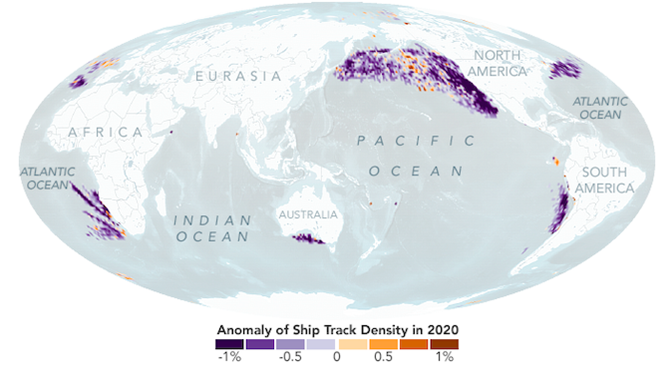
The global sulphur cap of 0.5% in ship fuel effectively reduced artificial “ship track” clouds to record-low levels in 2020. Pandemic-related disruptions played a secondary role.
Ship tracks, the polluted marine clouds that trail ocean-crossing vessels, are a signature of modern trade. Like ghostly fingerprints, they trace shipping lanes around the globe, from the North Pacific to the Mediterranean Sea. But in 2020, satellite observations showed fewer of those pollution fingerprints.
Drawing on nearly two decades of satellite imagery, researchers found that the number of ship track fell significantly after the 0.5% sulphur cap went into effect. A global standard implemented in 2020 by the International Maritime Organization (IMO) – requiring an 86% reduction in fuel sulphur content – likely reduced ship track formation. COVID-19-related trade disruptions also played a small role in the reduction.
Scientists used advanced computing techniques to create the first global climatology (a history of measurements) of ship tracks. They used artificial intelligence to automatically identify ship tracks across 17 years of daytime images (2003-2020) captured by NASA’s Moderate Resolution Imaging Spectroradiometer (Modis aboard the Aqua satellite.
“Without this kind of complete and large-scale sampling of ship tracks, we cannot begin to completely understand this problem,” said lead author Tianle Yuan, an atmospheric scientist at NASA’s Goddard Space Flight Center in Greenbelt, Maryland, and the University of Maryland, Baltimore County.
The opinions expressed herein are the author's and not necessarily those of The Xinde Marine News.
Please Contact Us at:
media@xindemarine.com


 Ningbo Containerized Freight Index Weekly Commentar
Ningbo Containerized Freight Index Weekly Commentar  Ningbo Containerized Freight Index Weekly Commentar
Ningbo Containerized Freight Index Weekly Commentar  Ningbo Containerized Freight Index Weekly Commentar
Ningbo Containerized Freight Index Weekly Commentar  BIMCO Shipping Number of the Week: Bulker newbuildi
BIMCO Shipping Number of the Week: Bulker newbuildi  Ningbo Containerized Freight Index Weekly Commentar
Ningbo Containerized Freight Index Weekly Commentar  Ningbo Containerized Freight Index Weekly Commentar
Ningbo Containerized Freight Index Weekly Commentar